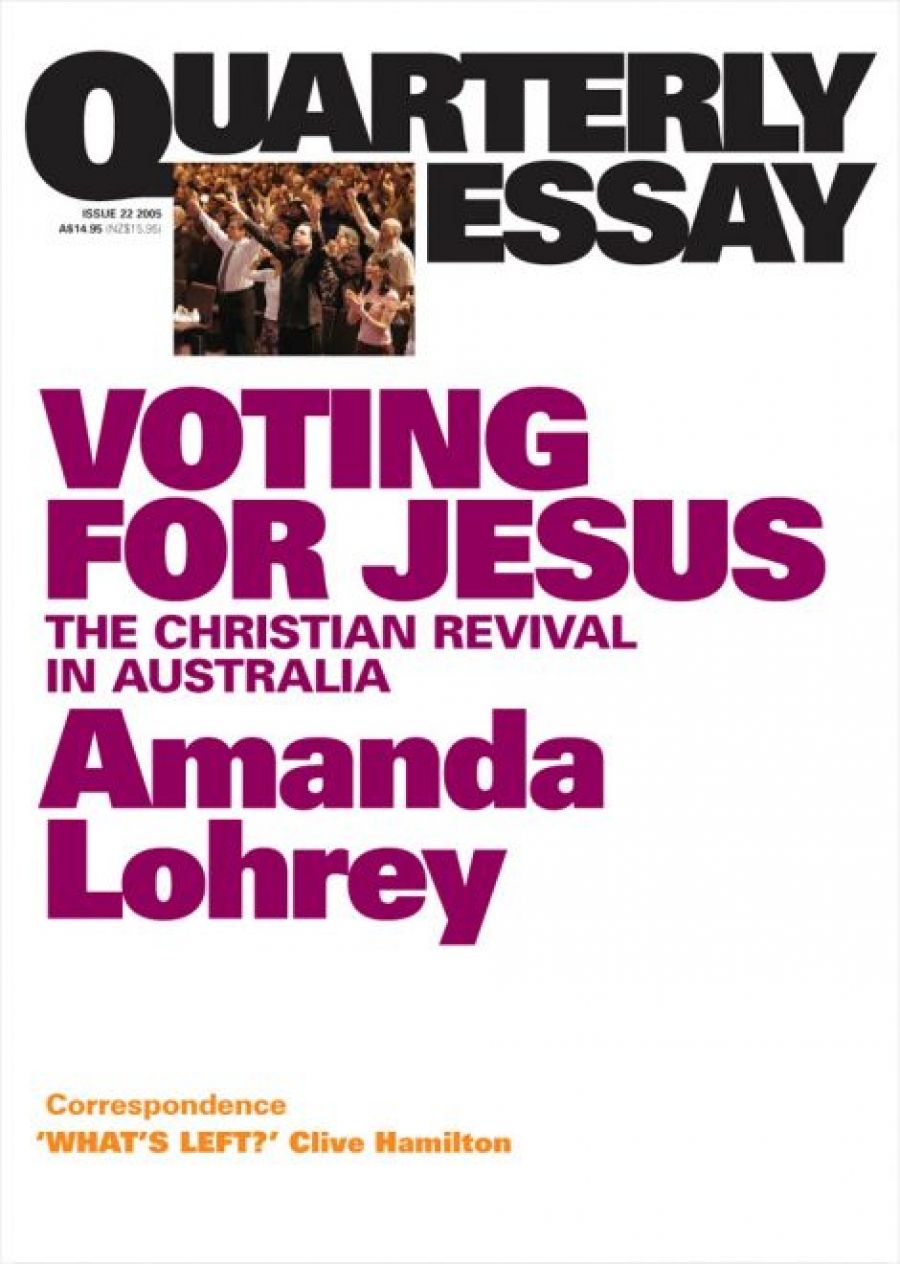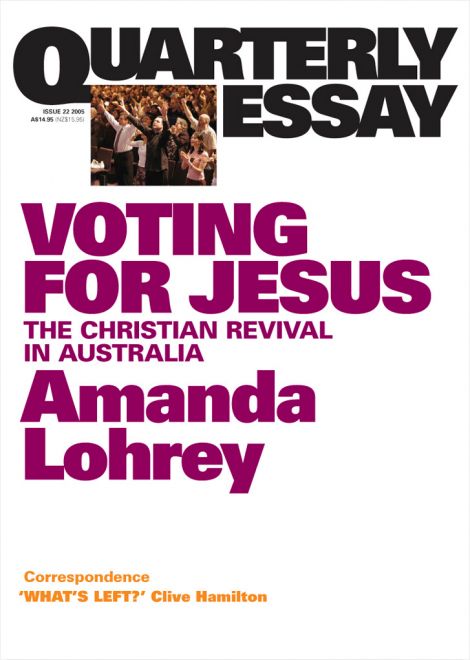
- Free Article: No
- Contents Category: Politics
- Review Article: Yes
- Article Title: Go straight to hell
- Online Only: No
- Custom Highlight Text:
In the week that Voting for Jesus landed in my letterbox, the Howard government announced that it was considering dollar-for-dollar support for state school chaplaincies, while, in New South Wales, fresh allegations surfaced of branch stacking by the state Liberals’ ‘religious right’ faction. Those perplexed by such developments in secular Australia will find novelist Amanda Lohrey a helpful, warm-hearted guide. Her colourful, impressionistic and approachable account of Australia’s religious right welcomes readers into a debate that some might previously have been inclined to dismiss as too confusing, or as marginal to secular concerns. Chats with academics, theologians and commentators offer a variety of angles. Far from adopting a didactic tone, the text beguiles with numerous questions that sound rhetorical but often remain unanswered.
- Book 1 Title: Quarterly Essay 22: Voting for Jesus
- Book 1 Subtitle: Christianity and politics in Australia
- Book 1 Biblio: Black inc., $14.95 pb, 112 pp
- Book 1 Cover Small (400 x 600):

- Book 1 Cover (800 x 1200):

Rather than offer detailed political analysis, Lohrey places recent developments in the broad frame of the ‘culture wars’ over values and morals. Emphasising this, her argument is book-ended by interviews with two groups of young Christians: some ‘cool girls’ from a Hillsong ‘cell’, and earnest spokespeople for a campus Evangelical Students’ Union. In their own words, the young people describe what Jesus means to them, which is sometimes touching (to one, Jesus literally made the difference between life and death) and sometimes chilling (as when they calmly consign their gay and lesbian friends to lifelong celibacy, and non-Christians to hell).
But, as Lohrey argues, the religion-and-politics story in Australia at the moment doesn’t really have much to do with cool cell members (who, statistics suggest, may soon leave not just Hillsong but churches of any kind, their places filled by a so-far endless stream of short-to-medium term converts). It is not about an imagined Christian groundswell, but about cynical political manipulation of willing mega-churches.
The first half gives a potted history of ‘prosperity gospel’ churches and their marketing approach to evangelism. It also discusses Sydney Anglican Archbishop Peter Jensen’s attempt, in his Boyer Lectures (2005), to project Jesus into Australians’ ‘watercooler conversations’. And Lohrey cannot resist some wry asides. New South Wales Tourism Minister Sandra Nori anticipates that a Mel Gibson-designed Stations of the Cross from the Opera House to St Mary’s Cathedral would not only beef up the economy but would ‘invigorate Australia’s religious life’. Lohrey expostulates: ‘First the Gay Mardi Gras and now this. Could there be no end to Sydney’s vulgarity?’
In the more political second half, Lohrey takes us further into church–state relations. Here, her impressionistic take can obscure her argument. For example, she reminds us that, ‘Despite all the colour and movement of the Pentecostals … the traditional churches are still the main religious game in town.’ She rightly challenges the common assumption that ‘Peter Costello wav[ing] his arms in the Hillsong auditorium’ and Family First’s Steve Fielding’s entering the Senate indicated a Christian revival sweeping Australia. But then: ‘no one thought to relay this information [of an alleged revival] to Pope Benedict XVI. In August 2005 the pope issued a dire warning: mainstream Christianity was dying out faster in Australia than anywhere else in the world.’ But the pope was talking, after all, about ‘mainstream Christianity’, and no one — not even Hillsong or Paradise Church (Family First’s home base) — thinks that Hillsong and Paradise are mainstream.
So where is the Christian mainstream? If mainline churches are the ‘main religious game in town’, they are surprisingly absent from Voting for Jesus. We hear a fair bit from Sydney’s deeply conservative — many say fundamentalist — Archbishop Jensen and his Catholic counterpart, Cardinal George Pell. But both, despite their high profile and seniority, represent minority stances within their own churches. The place of those churches in the current political landscape is considerably more complicated than Lohrey allows. According to Lohrey, mainline churches’ importance lies in ‘their hit rate as institutionalised lobbies in the area of the public purse’ for education and welfare, which tells ‘an impressive story of influence and calculation’.
But the influence and calculation was not mainly on the side of the churches. The drive to outsource welfare to church agencies came overwhelmingly from the government. Like President George W. Bush’s ‘faith-based institutions’, it reflects rhetorical positioning on the part of the government, not the churches. Far from angling for an ever-increasing share of the welfare pie, Australian churches have a long history of suspicion of government attempts to palm off welfare responsibilities onto them.
As I show in God Under Howard (2005), neo-liberal governments have numerous incentives to outsource welfare. Churches, historically reliant on volunteer labour and whose paid employees are attuned to a ‘service’ rather than ‘career’ ethos, can deliver services with minimal overheads (as Costello has gushed at a series of church charity launches). For similar historical reasons, church employees have exceptionally low levels of unionisation — the reverse of the public welfare agencies they often replaced (witness Tony Abbott’s boast in 2000 that the Job Network, in which church agencies were strongly represented, had broken the ‘union-dominated, bureaucratic monolith of the CES’). Most insidiously, once built into the government system through contracts, church agencies find it much harder to maintain their traditional advocacy for the victims of social inequality and critique of government policy. An increasingly common feature of such contractsover the Howard era became punitive ‘no criticism’ clauses.
On education, too, the story is more complicated than Lohrey suggests. She worries that:
Despite the fact that the ALP espoused policies that were closer to the publicly stated positions of the churches on almost every position — Iraq, refugees, industrial relations, social welfare — this was not enough of a moral incentive to override the perceived threat to church finances, and in the 2004 election the bishops spoke out against Labor on the basis of Latham’s policy of reducing state subsidy to the wealthiest of the church schools.
Her blanket attribution to ‘the bishops’ reflects much misreporting at the time. In fact, a joint press release was issued by archbishops in Sydney (Pell and Jensen again) and Melbourne. Despite media assertions that it included the ‘heads’ of the Anglican and Catholic churches, the Anglican Primate was not a signatory. The Uniting Church, Australia’s third-largest denomination and provider of forty-eight schools (and which has no bishops), was not involved. Churches of numerous denominations lobbied hard, and continue to do so, on Iraq, refugees, industrial relations and welfare, but without attracting the attention that met the four archbishops’ schools statement.
Voting for Jesus conveys much of the tone, colour and feel of Australia’s most religion-infused election for decades. Lohrey rightly points out Family First’s psephological irrelevance, and draws attention to its American Christian Coalition-like ‘stealth strategies’ (keep your religious identity quiet to avoid scaring secular voters). The trouble with stealth strategies is that you can only do them once: voters who were lulled into voting for neutral-seeming candidates are likely to cavil when they turn out to be Christian extremists. So it proved for New Zealand’s United Future (UFNZ), which, Lohrey reports, ‘now holds eight out of 120 parliamentary seats’. That was true until the September 2005 general election; but the almost uniformly fundamentalist Christian UFNZ members who slipped in below the media radar in the 2002 election (producing endless cartoon variations on the ‘Trojan Horse’ theme) were cut back to three in 2005, and that only because the leader holds an electorate seat, giving his party colleagues an advantage in New Zealand’s MMP system. After a term of near-invisibility in the government-controlled Senate, and lacking the UFNZ’s MMP-bestowed boost, Family First will surely drift even further into oblivion. And what of the major parties? Will the Liberals’ new-found religious positioning last, or will Australia’s traditional secularism reassert itself at the level of political rhetoric as well as reality? The answer depends on how the secular majority of voters read their politicians’ religious hints and winks. Lohrey concludes: ‘In the meantime, people in the community will go about their moral adjudications as they always have, on the basis of liberal humanist values and without need of instruction from the Christian Right.’


Comments powered by CComment